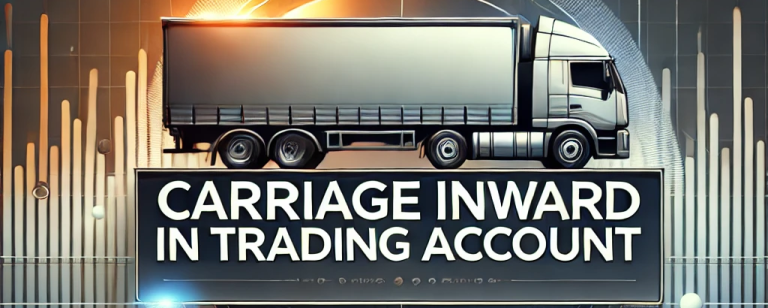Carriage inward in trading account is the cost of transporting the goods purchased to the buyer’s premises or warehouse. It is the cost incurred that is directly related to the purchase of goods, which is reflected in the trading account to depict the overall cost of selling the goods. Gross profit would depend on correct calculation if the treatment of carriage inward is proper. Thus, the right picture for the trading account cost of operations would be there. It is very essential to make a proper identification of carriage inward so that one gets to know the effect on profitability and, in fact, on the whole, financial performance.
What is Carriage Inward?
Carriage inward is the cost incurred by a business to bring purchased goods to its location or its warehouse. The expense is borne by the buyer and it is considered a direct expense. Carriage inward ensures that the purchased goods are ready for either production or sale and becomes an essential part of COGS.
All charges relating to transport, freight, and other logistic costs until the time that goods are received by the business from carriage inward are all included in the trading account since they directly affect the cost of goods.
For example, A company purchases raw materials at a cost of ₹50,000. It has incurred transportation expenses of ₹5,000. The carriage inward amounting to ₹5,000 will be added to the cost of purchase, which is ₹50,000. Hence the total cost of ₹55,000.
Key Features of Carriage Inward:
Carriage inward is the cost of movement brought to convey goods or raw materials into a business location. As an indispensable expense cost, it is combined with other purchases or costs of production such that one can know well the real cost to manufacture or to sell for this product sold. Do continue reading to know the further key characteristics of Carriage Inward.
- It is always paid by the buyer: There are costs such as transportation or delivery costs to bring goods to the buyer’s location. The seller does not cover this cost in his charge on price.
- Direct Expense of trading Account: This expense is directly involved in making the goods available in saleable form, such as delivery or loading charges, hence these costs are credited in the trading account and also become a part of the cost of the product.
- It does not raise the selling price but reduces the gross profit: Such expenditures are not included in raising the selling price of goods. Instead, they are subtracted from the profit since their increase raises the total cost of goods sold.
Significance of Carriage Inward
The significance of carriage inward is crucial for businesses so that it can be possible to operate with an optimum cost structure. It directly influences the gross profit and has insight into the efficiency of the supply chain and also into purchasing decisions.
- Accurate Gross Profit Calculation: It includes carriage inward also in the trading account so gross profit reflects all the costs of the goods sold.
- Cost Control: Carriage inward tracking will help businesses identify any inefficiencies in their logistics and minimize unnecessary expenses.
- Financial Accuracy: The inclusion of carriage inward in the trading account ensures strict accordance with accounting principles, thus reflecting true financial performance.
- Decision-Making: With this inward data, businesses might be able to bargain better transport contracts and optimize the procurement strategy.
Example in Trading Account
| Particulars | Amount (₹) |
| Purchases | 1,00,000 |
| Add: Carriage Inward | 10,000 |
| Total Cost of Goods | 1,10,000 |
By accounting for carriage inward, the business ensures accurate recording of all direct expenses.
Accounting for Carriage Inward
Carriage inward is recorded as a direct expense in the trading account. It ensures that all costs that are incurred towards selling, are reflected as part of the cost of goods sold so that the whole operation’s efficiency can be viewed at one glance.
The expense of transportation incurred to deliver items or raw materials to a business’s location is referred to as carriage inward. Since it immediately helps to prepare the items for use or sale, it is considered a direct expense and adds to the cost of the commodities bought in the trading account.
How to Account for Carriage Inward?
Carriage inward are cost incurred by a business in bringing goods or materials into its premises. Such an expense is usually considered a direct cost and, therefore, added to the cost of purchases or inventory in the books of accounts since it is necessary to prepare goods for sale or production. The detailed procedure of accounting carriage inward is mentioned below:-
- Recording in Journal: While incurring carriage inward expense, the same is directly debited to the “Carriage Inward Account” or trading account.
Journal Entry:
Carriage Inward A/c Dr. ₹XXX
To Bank/Balance Sheet A/c ₹XXX
- Ledger Posting: In the ledger, the Transfer of carriage inward is carried into the trading account because of its effect on trading profits.
- Trading Account: The amount of the carriage inward is simply incorporated under the head of purchases.
Example Journal Entry
Transfer the amount of carriage inward with the bank amount
Carriage Inward A/c Dr. 5,000
To Bank A/c 5,000
- Effect on Trading A/c:
| Particulars | Amount (₹) |
| Purchases | 1,00,000 |
| Add: Carriage Inward | 5,000 |
| Total | 1,05,000 |

Impact Of Carriage Inward On Financial Statements
The inclusion of carriage inward affects various financial statements, which makes it one of the most vital accounts in accounting and decision-making.
- Trading Account: Carriage inward increases the cost of total goods sold, thus reducing the gross profit.
- Profit and Loss Account: The profit and loss account directly influences the trading account, yet proper calculation of gross profit does influence the net profit.
- Balance Sheet: Indirectly affects retained earnings as gross profit leads to net profit, which is a part of equity.
Example of Trading Account showing Carriage Inward
| Trading Account (Partial) | Dr. (₹) | Cr. (₹) |
| Purchases | 1,00,000 | |
| Add: Carriage Inward | 5,000 | |
| Sales | 1,50,000 | |
| Gross Profit | 45,000 |
The expense of carriage inward decreases the gross profit, hence decreasing the profits of the business.
Carriage Inward in Trading Account FAQs
What is Carriage Inward?
Carriage Inward is the freight cost incurred to transport purchased goods to the business location. It is added to the cost of purchases and recorded on the debit side of the Trading Account.
Why is carriage inward added to the trading account?
Carriage inward is a direct cost of purchasing goods. Carriage inward addition to the trading account is essential for calculating the correct cost of sales and gross profit.
How does carriage inward impact financial statements?
Carriage inward increases the cost of goods sold, therefore reducing gross profit. Subsequently, this affects the net profit and equity on the balance sheet.
What is the difference between carriage inward and carriage outward?
Carriage inward is the transportation cost of goods purchased and is, therefore, a direct cost, while carriage outward concerns goods sold and is therefore an indirect cost.
Can carriage inward be capitalized?
Yes, if transportation cost is related to an asset acquisition, it could be capitalized as part of the asset cost.


